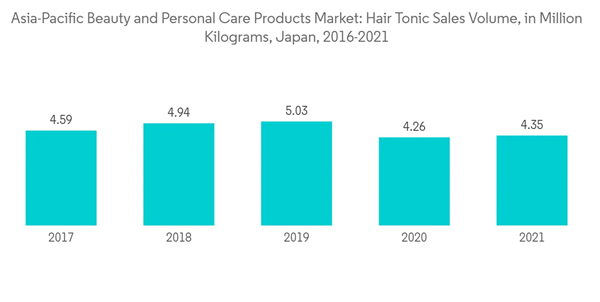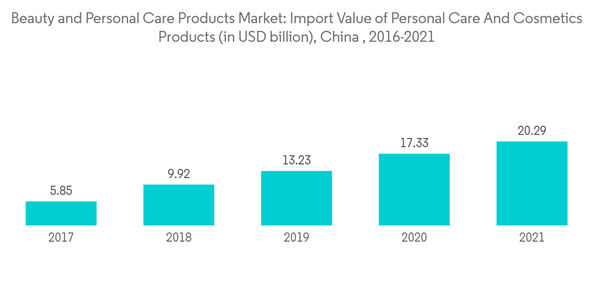The APAC Beauty and Personal Care Products Market size is estimated at USD 218.55 billion in 2024, and is expected to reach USD 302.82 billion by 2029, growing at a CAGR of 6.74% during the forecast period (2024-2029).
In Asia-Pacific, consumers have increased spending on personal hygiene, which has led to the escalated sales of shower gel, sanitizers, hand washes, etc. On the other hand, the e-commerce trend is boosting the sales of beauty and personal care products through online channels. Hence, players are turning their heads toward online channels. For instance, in 2021, Hindustan Unilever Ltd (HUL) announced its plans to scale up the online reach of the company's premium brands through standalone branded sites, as well as its multi-brand shopping platform UShop, wherein UShop (launched in the second half of 2020) is set to expand beyond the National Capital Region and Mumbai to eight more cities across the country.
Consumers across the region are inclined toward organic beauty and personal care products, especially those formulated using Ayurvedic, botanical, and herbal ingredients, which are expected to drive market growth during the study period. The rising awareness about the harmful effects of chemicals and synthetic products is another factor augmenting the growth of the market. Moreover, the rising premiumization and the consumers' need for more targeted solutions are accelerating the growth of personalized/customized beauty and personal care products. Furthermore, major players are intensely embarking on product innovation and mergers and acquisitions as their prime strategy to consolidate the market studied. For instance, in 2021, Kao Corporation, through its subsidiary Kao Salon Japan, launched its prestige hair salon brand, Oribe, in Japan. The brand consists of 23 product line-ups that were made widely available in Japan.
Furthermore, hair care product manufacturers have been heavily investing in research and development to experiment with new and improvised product formulations in shampoos, conditioners, hair tonics, serums, oils, and creams, which are gentle on the scalp and have regenerated properties to ensure faster hair growth and thicker volume. For instance, in January 2021, Emmbros Overseas, one of the fastest-growing Indian companies in the Beauty and HPC (Health and Personal Care) segment, introduced its premium hair care range titled the 'GO range' via St. Botanica. The range encompasses cruelty-free vegan shampoos, oils, serums, masks, and conditioners for specific hair requirements and concerns, including hair breakage, brittleness, fizziness, dandruff, hair fall, and sweat control, and is suitable for all hair types.
Moreover, with the growing demand for premium cosmetic products such as K-Beauty and C-Beauty in the country, players operating in the market are focusing on expanding their product portfolio to achieve significant market shares. For instance, in October 2021, Sephora China released more than 240 new beauty products from 51 brands, revealing the newness of 7 C-beauty brands and the domestic debut of five overseas niche brands. For the first time, Sephora launched its C-Beauty showroom to show the emerging power of premium local beauty brands, including exclusive makeup brands MAOGEPINGLIGHT and COLOR STUDIO BY MARIE DALGAR, together with the debut of luxury art beauty brand YUMEE, which brought more possibilities of beauty within Eastern narratives.
This product will be delivered within 2 business days.
In Asia-Pacific, consumers have increased spending on personal hygiene, which has led to the escalated sales of shower gel, sanitizers, hand washes, etc. On the other hand, the e-commerce trend is boosting the sales of beauty and personal care products through online channels. Hence, players are turning their heads toward online channels. For instance, in 2021, Hindustan Unilever Ltd (HUL) announced its plans to scale up the online reach of the company's premium brands through standalone branded sites, as well as its multi-brand shopping platform UShop, wherein UShop (launched in the second half of 2020) is set to expand beyond the National Capital Region and Mumbai to eight more cities across the country.
Consumers across the region are inclined toward organic beauty and personal care products, especially those formulated using Ayurvedic, botanical, and herbal ingredients, which are expected to drive market growth during the study period. The rising awareness about the harmful effects of chemicals and synthetic products is another factor augmenting the growth of the market. Moreover, the rising premiumization and the consumers' need for more targeted solutions are accelerating the growth of personalized/customized beauty and personal care products. Furthermore, major players are intensely embarking on product innovation and mergers and acquisitions as their prime strategy to consolidate the market studied. For instance, in 2021, Kao Corporation, through its subsidiary Kao Salon Japan, launched its prestige hair salon brand, Oribe, in Japan. The brand consists of 23 product line-ups that were made widely available in Japan.
Asia Pacific Beauty Devices Market Trends
Demand For Hair Care Products That Target Specific Issues
The hair care segment dominates the Asia-Pacific personal care products market. The demand for hair care and skin care is increasing in both rural and urban markets, leading to rising opportunities throughout the region. Consumers in urban areas spend three times as much on hair care and skin care products as compared to those in rural areas, providing significant scope for multiple brands to grow in the hinterlands. However, with the growing influence of media and television, rural consumers have been showcasing significant demand for hair coloring products, among others, which are often purchased in the sachet format in these areas. Amid the growing prevalence of hair thinning, loss of volume, dryness, and several other hair-related concerns among consumers, the hair care products that target these specific concerns are emerging as the most affluent and cost-effective ways to maintain hair health at home.Furthermore, hair care product manufacturers have been heavily investing in research and development to experiment with new and improvised product formulations in shampoos, conditioners, hair tonics, serums, oils, and creams, which are gentle on the scalp and have regenerated properties to ensure faster hair growth and thicker volume. For instance, in January 2021, Emmbros Overseas, one of the fastest-growing Indian companies in the Beauty and HPC (Health and Personal Care) segment, introduced its premium hair care range titled the 'GO range' via St. Botanica. The range encompasses cruelty-free vegan shampoos, oils, serums, masks, and conditioners for specific hair requirements and concerns, including hair breakage, brittleness, fizziness, dandruff, hair fall, and sweat control, and is suitable for all hair types.
China Holds the Largest Share
The increasing awareness about a healthier lifestyle among individuals for healthy and hygienic living has contributed to the increase in per capita expenditure on household products (including personal care products) across China. As per the National Bureau of Statistics of China, the per capita expenditure on household products (including personal care products) across China increased to USD 3,781.2 in 2021, a nominal increase of 13.6% over the previous year. China is one of the world's hotspots and fastest-changing beauty markets, introducing industry-leading innovations and setting trends globally. Products with claims such as UV protection, long-lasting, moisturizing/hydrating, botanical/herbal, whitening, and anti-aging, account for a considerable number of product launches. Haircare products with specific functions such as anti-greying and anti-hair fall are witnessing significant growth, owing to the high adoption rate among the millennials and Gen-Z population. Brands are also coming up with customized approaches to cater to the growing demand. For instance, in May 2021, L'Oréal Paris launched an omnichannel concept store in collaboration with AKQA in Shanghai, offering visitors a personalized experience and cultivating a better relationship with customers.Moreover, with the growing demand for premium cosmetic products such as K-Beauty and C-Beauty in the country, players operating in the market are focusing on expanding their product portfolio to achieve significant market shares. For instance, in October 2021, Sephora China released more than 240 new beauty products from 51 brands, revealing the newness of 7 C-beauty brands and the domestic debut of five overseas niche brands. For the first time, Sephora launched its C-Beauty showroom to show the emerging power of premium local beauty brands, including exclusive makeup brands MAOGEPINGLIGHT and COLOR STUDIO BY MARIE DALGAR, together with the debut of luxury art beauty brand YUMEE, which brought more possibilities of beauty within Eastern narratives.
Asia Pacific Beauty Devices Industry Overview
Some of the key players in the beauty and personal care products market in Asia-Pacific include Unilever PLC, Revlon Inc., Shiseido Co. Ltd, Beiersdorf AG, L'Oreal Group, Procter & Gamble, and The Estée Lauder Companies Inc. L'Oréal SA is one of the most active companies, with numerous brand offerings and a broad range of beauty and skincare products across the region. The company has spent considerably on improving quality and product innovation in terms of ingredients, functionality, and packaging as its key strategy to increase its geographical presence and customer base. Additionally, companies are innovating their products and advertising advanced and niche categories, which can eliminate recurring problems faced by consumers due to pollution, aging, and lack of time for care.Additional Benefits:
- The market estimate (ME) sheet in Excel format
- 3 months of analyst support
This product will be delivered within 2 business days.
Table of Contents
1 INTRODUCTION
4 MARKET DYNAMICS
5 MARKET SEGMENTATION
6 COMPETITIVE LANDSCAPE
Companies Mentioned (Partial List)
A selection of companies mentioned in this report includes, but is not limited to:
- L'Oréal SA
- Procter & Gamble Company
- Beiersdorf AG
- Natura & Co
- Unilever PLC
- The Estée Lauder Companies Inc.
- Shiseido Company Limited
- Kao Corporation
- Revlon Inc.
- Oriflame Holding AG
Methodology

LOADING...










